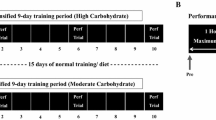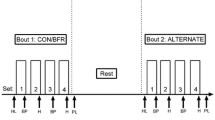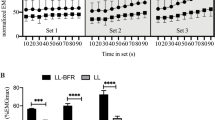Abstract
Seven weight-trained males performed both light resistance with partial occlusion (LRO: 30% 1 RM) and moderate resistance (MR: 70% 1 RM) to failure to ascertain whether blood protein carbonyls (PC) and glutathione status was altered compared to partial occlusion (PO) in a counterbalanced fashion. PO was identical in duration to the LRO session and all sessions were on separate days. PC did not differ for the three conditions at PRE (0.05 nM mg protein−1). PC significantly increased for PO and MR over time and was greater than the LRO treatment at POST (0.13 nM mg protein−1). The GSSG/TGSH ratio at PRE did not differ across treatments (8%) whereas the ratio at POST was significantly elevated for PO and MR treatments (17%). In contrast, no change occurred for the LRO session at any time. These results indicate that MR to failure and PO can significantly increase blood oxidative stress but LRO did not elicit oxidative stress.


Similar content being viewed by others
References
Abe T, Kearns CF, Sato Y (2006) Muscle size and strength are increased following walk training with restricted venous blood flow from the leg muscle, KAATSU-walk training. J Appl Physiol 100:1460–1466
Alessio HM, Hagerman AE, Fulkerson BK et al (2000) Generation of reactive oxygen species after exhaustive aerobic and isometric exercise. Med Sci Sports Exerc 32:1576–1581
Andersen ME (1985) Determination of glutathione and glutathione disulfide in biological samples. Methods Enzymol 113:548–555
Bloomer RJ, Fry AC, Falvo MJ et al (2007) Protein carbonyls are acutely elevated following single set anaerobic exercise in resistance trained men. J Sci Med Sport 10:411–417
Burgomaster KA, Moore DR, Schofield LM et al (2003) Resistance training with vascular occlusion: metabolic adaptations in human muscle. Med Sci Sports Exerc 35:1203–1208
Doussett E, Steinberg EG, Faucher M et al (2002) Acute hypoxia does not increase the oxidative stress in resting and contracting skeletal muscle. Free Rad Res 36:701–704
Durand RJ, Castracane VD, Hollander DB et al (2003) Hormonal responses from concentric and eccentric muscle contractions. Med Sci Sports Exerc 35:937–943
Goldfarb AH, Bloomer RJ, McKenzie MJ (2005) Combined antioxidant treatment effects on blood oxidative stress to eccentric exercise. Med Sci Sports Exerc 37:234–239
Gute DC, Ishida T, Yarimizu K et al (1998) Inflammatory response to ischemia and reperfusion in skeletal muscle. Mol Cell Biochem 179:169–187
Hudson MB, Hosick PA, McCaulley GO et al (2008) The effect of resistance exercise on humoral markers of oxidative stress. Med Sci Sports Exerc 40:542–548
Jackson AS, Pollock ML (1985) Practical assessment of body composition. J Sports Med Phys Fitness 13:76–90
Korthuis JK, Granger DN, Townsley MI et al (1985) The role of oxygen-derived free radicals in ischaemia-induced increases in skeletal muscle vascular permeability. Circ Res 57:599–609
Kraemer WJ, Ratamess NA (2005) Hormonal responses and adaptations to resistance exercise and training. Sports Med 35:339–361
Kraemer WJ, Marchitelli L, Gordon SE et al (1990) Hormonal and growth factor responses to heavy resistance exercise protocols. J Appl Physiol 69:1442–1450
Lowry OH, Rosenbrough NJ, Farr AL et al (1951) Protein measurement with the Folin phenol reagent. J Bio Chem 193:265–275
McBride JM, Kraemer WJ, Triplett-McBride T et al (1998) Effect of resistance exercise on free radical production. Med Sci Sports Exerc 30:67–72
McDonagh MJN, Davies CTM (1984) Adaptive response of mammalian skeletal muscle to exercise with high loads. Eur J Appl Physiol 52:139–155
Reeves GV, Kraemer RR, Hollander DB et al (2006) Comparison of hormone responses following light resistance exercise with partial occlusion and moderately difficult resistance exercise without occlusion. J Appl Physiol 101:1616–1622
Rietjens SJ, Beelen M, Koopman R et al (2007) A single session of resistance exercise induces oxidative damage in untrained men. Med Sci Sports Exerc 39:2145–2151
Stadtman ER, Levine RL (2000) Protein oxidation. Ann N Y Acad Sci 899:191–208
Takarada Y, Nakamura Y, Aruga S et al (2000a) Rapid increase in plasma growth hormone after low-intensity resistance exercise with vascular occlusion. J Appl Physiol 88:61–65
Takarada Y, Takazawa H, Sato Y et al (2000b) Effects of resistance exercise combined with moderate vascular occlusion on muscular function in humans. J Appl Physiol 88:2097–2106
Tsutsumi YM, Yokoyama T, Horikawa Y et al (2007) Reactive oxygen species trigger ischemic and pharmacological postconditioning: in vivo and in vitro characterization. Life Sci 81:1223–1227
Uchiyama S, Tsukamoto H, Yoshimura S et al (2006) Relationship between oxidative stress in muscle tissue and weight-lifting-induced muscle damage. Pflugers Arch 452:109–116
Winterbourn CC, Buss IH (1999) Protein carbonyl measurement by enzyme-linked immunosorbent assay. Methods Enzymol 300:106–111
Author information
Authors and Affiliations
Corresponding author
Rights and permissions
About this article
Cite this article
Goldfarb, A.H., Garten, R.S., Chee, P.D.M. et al. Resistance exercise effects on blood glutathione status and plasma protein carbonyls: influence of partial vascular occlusion. Eur J Appl Physiol 104, 813–819 (2008). https://doi.org/10.1007/s00421-008-0836-1
Accepted:
Published:
Issue Date:
DOI: https://doi.org/10.1007/s00421-008-0836-1




